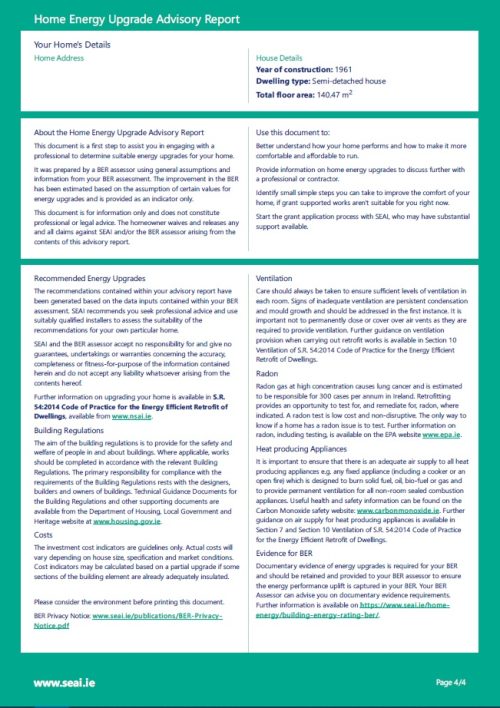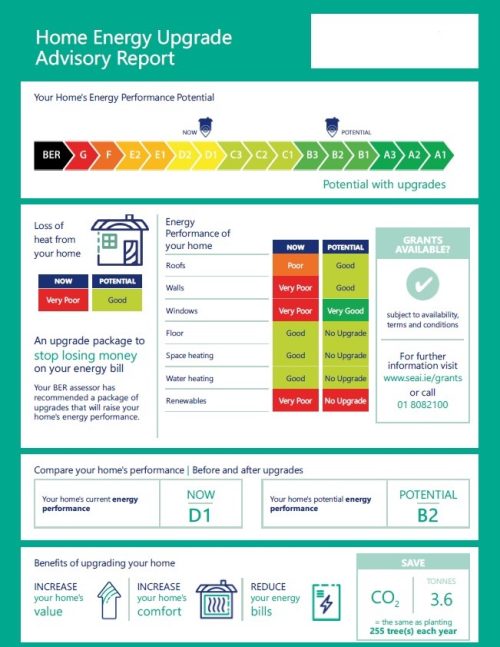The BER Advisory Report
The Building Energy Rating (BER) advisory report is a document that is produced along with a BER certificate when it is being published by the SEAI. The information contained within it, is auto-generated with direction from the assessor based on the data collected during the assessment. It provides recommendations on how to improve the energy performance of a building.
The BER assessors final task before publishing the BER certificate is to assign a selection of potential upgrades to be carried out on a property to improve it’s BER. These are based on a list of suggestions provided by the SEAI software which is used to calculate the BER.
Depending on the calculated BER from the assessment, a target BER will be required by the SEAI for the advisory report. For example, an assessment results in a G rated property and it might have a target of B3 BER for the advisory report. Or an assessment results in a C1 rated property and might have a target BER of B1 for the report.
When carrying out this task the assessor is given a summary list of all the building elements that will affect the BER result. They are also presented with options of different upgrades, for each element on the list, to select from so as to hypothetically improve the energy efficiency of that building element. Selecting different options will change the hypothetical BER result.
For example: a property has single glazed windows. When creating the advisory report the assessor will have the option to select either double glazed windows, triple glazed windows or to leave the single glazed windows as is. The software will show what the BER would be if each option were to be selected.
The BER advisory reports’ potential result is decided by the SEAI software, but the measures suggested to achieve that result is entirely up to the BER assessors discretion. They use a combination of their understanding of the property, the associated costs and the likely levels of disruption to try and select the best options for each property to achieve the target result.
It must be noted that there are always different options of energy efficiency upgrades that could be selected to achieve the potential BER. This document is to be used as a first step guide for your energy efficiency journey. You are entirely within your rights, based on your own knowledge of the property or other expert guidance, to choose a different selection of measures to improve the BER. If you are aspiring to achieve a specific BER grade, we strongly recommend consulting with expert guidance. You can learn more about how to improving the BER here.
Advisory Report page 1
The BER advisory report is a four page document. Page one is a summary page which shows:
- the new BER rating as shown on the BER certificate
- the potential BER rating if all of the suggested energy efficiency improving measures from page 2 are carried out
- a table describing each of the principle elements that impact the BER, how each element rates based on the BER assessment (very poor, poor, good, etc…) and how each element would rate following the proposed upgrades
- An estimate of the amount of C02 emissions that would be saved if the proposed upgrades are implemented
Advisory Report page 2
Page 2 of the advisory report shows a table listing out the BER assessor suggested upgrades. These suggestions are alongside three columns which give guidelines for the cost of a measure, if a grant is available and what impact the measure will have on the comfort of your property.
The cost and the comfort columns are somewhat ambiguous. Due to ever changing prices of labour and materials. Costs have varied significantly over the years and improvement in comfort is difficult to quantify.
Many of the measures will be defined by their target U-value. A U-value is a measure of how well a material, like a window or wall, is able to conduct heat. U-values are usually expressed in units of watts per square meter per degree Kelvin (W/m²K), and are used to help determine the rate of heat loss for a building element or construction material. Learn more about U-values here
Advisory Report page 3
Page 3 of the BER advisory report expands on the information from pages 1 and 2. The table lists the “Heat Loss Indicator” (HLI), the suggested energy upgrades and the renewable energy ratio.
The HLI is based on the total heat loss through the fabric and ventilation of the dwelling divided by the total floor area. It is calculated by the SEAI software following the BER assessment and reflects the rate of heat loss of the dwelling at the time of the assessment.
Each element of the building included for suggested energy upgrades is shown in the table alongside: it’s current U-value; how it’s current energy efficiency rates; the resulting U-value if the proposed upgrade is implemented; and how that upgraded element will rate.
The “Renewable Energy Ratio” is a percentage based on how much of the energy a property uses against the amount of energy it saves through renewable energy technologies such as solar PV, if installed.
Advisory Report page 4
Page 4 of the BER advisory report shows basic details recorded from the survey, including: The year of construction of the property, the type of property (Apartment, terraced house, etc…) and the total floor area of the property.
The rest of the information provided is standard and identical for each report. On this page, SEAI explains what the advisory report is for, how it can be used, guidance around upgrades, guidance around building regulations and disclaimers about how the information on the report is to be used.




